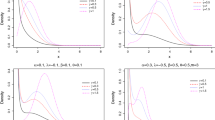Abstract
The renewal functions (RFs) of most distribution functions do not have closed-form expressions while such expressions are desired for the optimization problems involved RF. Many efforts have been made to develop approximations of RF. However, it seems that no RF approximation is accurate enough in the entire time range. In this paper, we propose two RF approximations. The first approximation is obtained through smoothly connecting two limiting relations and fairly accurate in the entire time range. The second approximation has the same function form as the first part of the first approximation but the model parameter is determined in a different way so as to achieve higher accuracy for small to moderate time range. The expressions of the proposed approximations are simple and applicable for any arbitrary lifetime distribution. Their accuracy is analyzed and, the appropriateness and usefulness are illustrated by a numerical example.





Similar content being viewed by others
References
Ayhan, H., Limon-Robles, J., & Wortman, M. A. (1999). Approach for computing tight numerical bounds on renewal functions. IEEE Transactions on Reliability, 48(2), 82–188.
Blischke, W. P., & Murthy, D. N. P. (2003). Case studies in reliability and maintenance. New Jersey: Wiley.
Brezavšček, A. (2016). Stochastic approach to planning of spares for complex deteriorating industrial system. Quality Technology and Quantitative Management, 12(4), 465–480.
Çetinkaya, S., Tekin, E., & Lee, C. (2008). A stochastic model for joint inventory and outbound shipment decisions. IIE Transactions, 40(3), 324–340.
Chaudhry, M. L. (1995). On computations of the mean and variance of the number of renewals: A unified approach. Journal of the Operational Research Society, 46(11), 1352–1364.
Constantine, A. G., & Robinson, N. I. (1997). Weibull renewal function for moderate to large arguments. Computational Statistics & Data Analysis, 24(1), 9–27.
Cui, L., & Xie, M. (2003). Some normal approximations for renewal function of large Weibull shape parameter. Communications in Statistics-Simulation and Computation, 32(1), 1–16.
Daley, D. J., & Vesilo, R. (1997). Long range dependence of point processes, with queueing examples. Stochastic Processes and their Applications, 70(2), 265–282.
Dohi, T., Kaio, N., & Osaki, S. (2002). Renewal processes and their computational aspects. In Stochastic models in reliability and maintenance (pp. 1–30). Berlin, Springer.
From, S. G. (2001). Some new approximations for the renewal function. Communications in Statistics-Simulation and Computation, 30(1), 113–128.
Garg, A., & Kalagnanam, J. R. (1998). Approximations for the renewal function. IEEE Transactions on Reliability, 47(1), 66–72.
Gertsbakh, I., & Shpungin, Y. (2004). Renewal function and interval availability: A numerical Monte–Carlo study. Communications in Statistics. Theory and Methods, 33(3), 639–649.
Ghodrati, B. (2011). Efficient product support—Optimum and realistic spare parts forecasting. In L. Tadj, et al. (Eds.), Replacement models with minimal repair (pp. 225–269). London: Springer-Verlag London Limited.
Jiang, R. (2008). A Gamma–normal series truncation approximation for computing the Weibull renewal function. Reliability Engineering and System Safety, 93(4), 616–626.
Jiang, R. (2010). A simple approximation for the renewal function with an increasing failure rate. Reliability Engineering and System Safety, 95(9), 963–969.
Jiang, R. (2015). Product warranty. Introduction to quality and reliability engineering (pp. 283–301). Berlin: Springer.
Jiang, R. (2018). Performance evaluation of seven optimization models of age replacement policy. Reliability Engineering and System Safety, 180, 302–311.
Jiang, R., & Murthy, D. N. P. (2008). Maintenance: Decision models for management. Beijing: Science Press.
Jin, T., & Gonigunta, L. (2009). Weibull and gamma renewal approximation using generalized exponential functions. Communications in Statistics: Simulation and Computation, 38(1), 154–171.
Kumar, U. D., Crocker, J., Knezevic, J., & El-Haram, M. (2000). Reliability, maintenance and logistic support: A life cycle approach. Dordrecht: Kluwer Academic Publishers.
Lin, P. C., & Shue, L. Y. (2005). Application of optimal control theory to product pricing and warranty with free replacement under the influence of basic lifetime distributions. Computers & Industrial Engineering, 48(1), 69–82.
Parsa, H., & Jin, M. (2013). An improved approximation for the renewal function and its integral with an application in two-echelon inventory management. International Journal of Production Economics, 146(1), 142–152.
Rao, B. M. (1995). Algorithms for the free replacement warranty with phase-type Iifetime distributions. IIE Transactions, 27(3), 348–357.
Riascos-Ocho, J., Sanchez-Silva, M., & Akhavan-Tabatabaei, R. (2014). Reliability analysis of shock-based deterioration using phase-type distributions. Probabilistic Engineering Mechanics, 38(38), 88–101.
Samanta, S. K., Chaudhry, M. L., Pacheco, A., & Gupta, U. C. (2015). Analytic and computational analysis of the discrete-time GI/D-MSP/1 queue using roots. Computers & Operations Research, 56, 33–40.
Smeitink, E., & Dekker, R. (1990). A simple approximation to the renewal function. IEEE Transactions on Reliability, 39(1), 71–75.
Spearman, M. L. (1989). A simple approximation for IFR Weibull renewal functions. Microelectronics Reliability, 29(1), 73–80.
Xie, M. (1989). On the solution of renewal-type integral equations. Communications in Statistics-Simulation and Computation, 18(1), 281–293.
Zacks, S. (2010). The availability and hazard of a system under a cumulative damage process with replacements. Methodology and Computing in Applied Probability, 12(4), 555–565.
Acknowledgements
The research was supported by the National Natural Science Foundation of China (No. 71771029).
Author information
Authors and Affiliations
Corresponding author
Additional information
Publisher's Note
Springer Nature remains neutral with regard to jurisdictional claims in published maps and institutional affiliations.
Appendix A: Renewal function of the Weibull distribution
Appendix A: Renewal function of the Weibull distribution
The exact values of RF of the Weibull distribution with \( \eta = 1 \) and \( \beta = 1.5(0.5)3.5 \) are shown in Table 4.
Rights and permissions
About this article
Cite this article
Jiang, R. Two approximations of renewal function for any arbitrary lifetime distribution. Ann Oper Res 311, 151–165 (2022). https://doi.org/10.1007/s10479-019-03356-2
Published:
Issue Date:
DOI: https://doi.org/10.1007/s10479-019-03356-2




